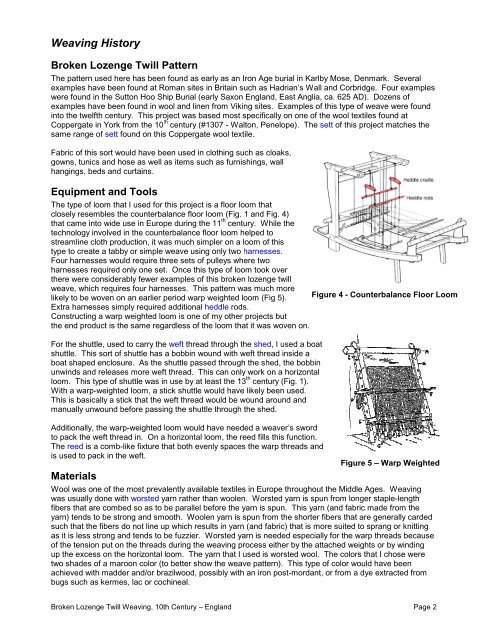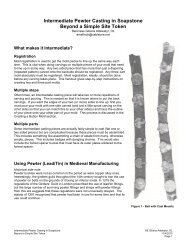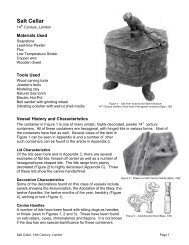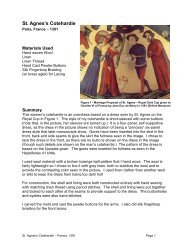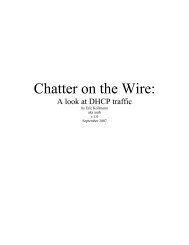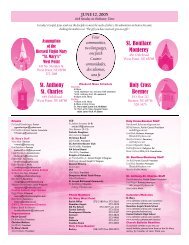Create successful ePaper yourself
Turn your PDF publications into a flip-book with our unique Google optimized e-Paper software.
<strong>Weaving</strong> History<br />
<strong>Broken</strong> <strong>Lozenge</strong> <strong>Twill</strong> Pattern<br />
The pattern used here has been found as early as an Iron Age burial in Karlby Mose, Denmark. Several<br />
examples have been found at Roman sites in Britain such as Hadrian’s Wall and Corbridge. Four examples<br />
were found in the Sutton Hoo Ship Burial (early Saxon England, East Anglia, ca. 625 AD). Dozens of<br />
examples have been found in wool and linen from Viking sites. Examples of this type of weave were found<br />
into the twelfth century. This project was based most specifically on one of the wool textiles found at<br />
Coppergate in York from the 10 th century (#1307 - Walton, Penelope). The sett of this project matches the<br />
same range of sett found on this Coppergate wool textile.<br />
Fabric of this sort would have been used in clothing such as cloaks,<br />
gowns, tunics and hose as well as items such as furnishings, wall<br />
hangings, beds and curtains.<br />
Equipment and Tools<br />
The type of loom that I used for this project is a floor loom that<br />
closely resembles the counterbalance floor loom (Fig. 1 and Fig. 4)<br />
that came into wide use in Europe during the 11 th century. While the<br />
technology involved in the counterbalance floor loom helped to<br />
streamline cloth production, it was much simpler on a loom of this<br />
type to create a tabby or simple weave using only two harnesses.<br />
Four harnesses would require three sets of pulleys where two<br />
harnesses required only one set. Once this type of loom took over<br />
there were considerably fewer examples of this broken lozenge twill<br />
weave, which requires four harnesses. This pattern was much more<br />
likely to be woven on an earlier period warp weighted loom (Fig 5).<br />
Extra harnesses simply required additional heddle rods.<br />
Constructing a warp weighted loom is one of my other projects but<br />
the end product is the same regardless of the loom that it was woven on.<br />
For the shuttle, used to carry the weft thread through the shed, I used a boat<br />
shuttle. This sort of shuttle has a bobbin wound with weft thread inside a<br />
boat shaped enclosure. As the shuttle passed through the shed, the bobbin<br />
unwinds and releases more weft thread. This can only work on a horizontal<br />
loom. This type of shuttle was in use by at least the 13 th century (Fig. 1).<br />
With a warp-weighted loom, a stick shuttle would have likely been used.<br />
This is basically a stick that the weft thread would be wound around and<br />
manually unwound before passing the shuttle through the shed.<br />
Additionally, the warp-weighted loom would have needed a weaver’s sword<br />
to pack the weft thread in. On a horizontal loom, the reed fills this function.<br />
The reed is a comb-like fixture that both evenly spaces the warp threads and<br />
is used to pack in the weft.<br />
Materials<br />
Figure 4 - Counterbalance Floor Loom<br />
Figure 5 – Warp Weighted<br />
Wool was one of the most prevalently available textiles in Europe throughout the Middle Ages. <strong>Weaving</strong><br />
was usually done with worsted yarn rather than woolen. Worsted yarn is spun from longer staple-length<br />
fibers that are combed so as to be parallel before the yarn is spun. This yarn (and fabric made from the<br />
yarn) tends to be strong and smooth. Woolen yarn is spun from the shorter fibers that are generally carded<br />
such that the fibers do not line up which results in yarn (and fabric) that is more suited to sprang or knitting<br />
as it is less strong and tends to be fuzzier. Worsted yarn is needed especially for the warp threads because<br />
of the tension put on the threads during the weaving process either by the attached weights or by winding<br />
up the excess on the horizontal loom. The yarn that I used is worsted wool. The colors that I chose were<br />
two shades of a maroon color (to better show the weave pattern). This type of color would have been<br />
achieved with madder and/or brazilwood, possibly with an iron post-mordant, or from a dye extracted from<br />
bugs such as kermes, lac or cochineal.<br />
<strong>Broken</strong> <strong>Lozenge</strong> <strong>Twill</strong> <strong>Weaving</strong>, 10th Century – England Page 2


